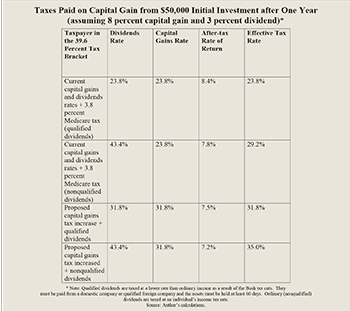Taxing the nonwage income of the wealthy is politically popular because it is assumed few people will be affected. President Obama’s 2016 budget proposes an increase in the capital gains tax to 28 percent for couples earning $500,000 or more.
This is estimated to increase revenue about $208 billion over 10 years. In his State of the Union address, Obama noted the Reagan administration established the same rate, as if to minimize the effects of the proposal. But the comparison is not apt; President Reagan lowered marginal tax rates during his tenure, and there was no Medicare tax on unearned income, as there is now. What would be the effect if the capital gains tax increased from its current 20 percent to 28 percent?
Tax Increases during the Obama Administration. In 2013, Congress and the president imposed new taxes on high-income individuals:
- They added a 39.6 marginal tax rate for the highest-income households. In tax year 2014, this rate applied to singles earning more than $406,751 and to married couples earning more than $457,601.
- The new health care reform law impose an additional 0.9 percent Medicare tax on individuals with wages above $200,000 and on couples with wages in excess of $250,000.
- Additionally, a 3.8 percent Medicare tax was imposed on unearned income (dividends, royalties, rental income, capital gains) in excess of $200,000 for singles, and over $250,000 for couples.
When the Medicare tax on unearned income took effect in 2013, the effective (average) tax rate on capital gains for a household in the highest tax bracket went from 15 percent to 23.8 percent.
Capital Gains and Dividends Taxes. Capital gains are the amount by which an asset’s selling price exceeds its purchase price. Under current law, capital gains on assets held more than a year are taxed at a flat 15 percent rate for most taxpayers. The capital gains of taxpayers in the 10 percent and 15 percent federal income tax brackets are not taxed at all. The capital gains rate for taxpayers in the 39.6 percent tax bracket is 20 percent. Capital gains on assets held less than a year are taxed at an individual’s ordinary income tax rate. Qualified dividends — paid by American companies or qualified foreign companies on stock held for at least 60 days — are currently taxed at 20 percent for the highest-income earners, whereas ordinary (nonqualified) dividends and interest are taxed at regular income tax rates.

Before- and After-tax Rate of Return. Consider a couple earning more than $500,000. Suppose the couple owns $50,000 of stock that has accumulated an 8 percent capital gain and 3 percent dividend after one year. The total pretax rate of return on the $50,000 investment (sold after one year) would be 11 percent. However [see the table]:
- With the current capital gains tax rate of 20 percent plus the 3.8 percent Medicare tax, the tax on a $50,000 stock sale would be $1,309, and the after-tax rate of return would be 8.4 percent [see the first row of table].
- If President Obama’s proposed capital gains and dividends rate of 28 percent were in effect, the couple’s tax bill would increase to $1,749 and the after-tax return would fall to 7.5 percent.
- If the dividends were nonqualified and taxed at the ordinary income tax rate of 39.6 percent, the couple’s effective (average) tax rate would increase from 29 percent to nearly 35 percent, and reduce the return on investment by two-thirds of a percentage point to 7.2 percent [see the last row of table].
The Lock-in Effect. Since the 1950s, researchers have studied the effect of increased capital gains taxes on investment behavior. They have found a tendency for asset holders to either sell assets prior to an increase in capital gains or delay selling them when a tax increase takes place. This “lock-in” effect discourages risk taking, leads to poor decision-making on the part of investors, and may also reduce anticipated tax revenues
The woes of wealthy shareholders concern few policymakers, but the capital gains tax is especially harmful to entrepreneurs starting or expanding their businesses. The most recent Federal Reserve Survey of Consumer Finances (2013) shows the share of families holding business equity (classified as sole proprietorships, limited partnerships, S corporations and other types of privately-held businesses) fell from 13.3 percent in 2010 to 11.7 percent in 2013, the lowest level since 1989.
States Tax Capital Gains, Too. In addition to federal capital gains taxes, 41 states also tax capital gains. California, for instance, has the highest marginal capital gains tax rate, 13.3 percent. Economist William Gentry of Williams College studies the effect of state-level capital gains taxes on funds disbursed to entrepreneurs by venture capitalists. Using data from the SCF from 1969 to 2007, he concluded a one-percentage point increase in a state’s marginal capital gains tax rate reduced venture capital disbursements by $1.28 to $3.48 per capita in that state. In other words, states with higher capital gains tax rates have less private financial backing for entrepreneurs.
Conclusion. Capital gains tax hikes do not just affect the wealthy; they affect anyone at any income level who needs access to capital. In today’s struggling entrepreneurial climate, policymakers can ill-afford to impose additional taxes on productive workers and small businesses, or reduce the rate of return on capital investment.
Pamela Villarreal is a senior fellow with the National Center for Policy Analysis.